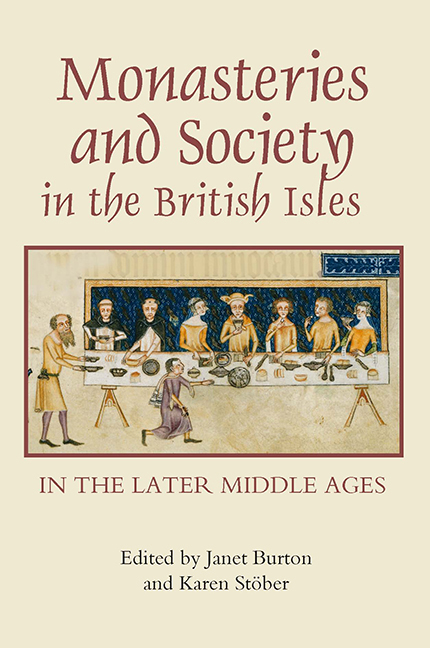Book contents
- Frontmatter
- Contents
- List of illustrations
- Acknowledgements
- List of contributors
- Abbreviations
- Introduction
- The Meeting of the Worlds
- Religious Houses and their Patrons and Benefactors
- Female Communities: Nuns, Abbesses and Prioresses
- 8 Looking for medieval nuns
- 9 ‘Quhat say ye now, my lady priores? How have ye usit your office, can ye ges?’: Politics, power and realities of the office of a prioress in her community in late medieval Scotland
- Monasteries and Education
- Monasteries and Urban Space
- Religious Houses in the Regions
- Index of Religious Houses mentioned in the text
- Index
- Miscellaneous Endmatter
9 - ‘Quhat say ye now, my lady priores? How have ye usit your office, can ye ges?’: Politics, power and realities of the office of a prioress in her community in late medieval Scotland
from Female Communities: Nuns, Abbesses and Prioresses
Published online by Cambridge University Press: 24 October 2017
- Frontmatter
- Contents
- List of illustrations
- Acknowledgements
- List of contributors
- Abbreviations
- Introduction
- The Meeting of the Worlds
- Religious Houses and their Patrons and Benefactors
- Female Communities: Nuns, Abbesses and Prioresses
- 8 Looking for medieval nuns
- 9 ‘Quhat say ye now, my lady priores? How have ye usit your office, can ye ges?’: Politics, power and realities of the office of a prioress in her community in late medieval Scotland
- Monasteries and Education
- Monasteries and Urban Space
- Religious Houses in the Regions
- Index of Religious Houses mentioned in the text
- Index
- Miscellaneous Endmatter
Summary
Historians have claimed that Scottish female religious houses and their inhabitants are not worthy of study. Traditionally the reasons they have given are the paucity of the sources about convents and nuns, the smallness of the houses themselves, the lack of importance that convents had in the locale, and the claim that female houses are simply ‘too different’ from male houses and therefore prove problematic in any study of medieval monasticism. Because of these assumptions, little work has been done on any aspect of female religious houses and nothing at all on female heads of houses. Indeed, Scottish historians have shied away from any discussion of medieval heads of houses, male or female: the publication Heads of Religious Houses in Scotland is concerned merely with the identification of abbots, priors and prioresses, with little further discussion. In fact, very little has been done on heads of religious houses for the later medieval period in Britain or on the Continent. Studies of female heads tend to focus on the early or central Middle Ages, when an abbess or prioress appears to have exercised a considerable degree of influence in her secular and religious community; these women were often of a particular rank, such as daughters of kings or members of the higher nobility, which allowed them to exercise authority and obtain a degree of independence. When we move to the later Middle Ages, however, what studies we do have of abbesses and prioresses tend to argue for a shift from their earlier positions of power, authority and influence. The confident picture of the influential role of female superiors begins to change, and we find female heads of houses being heavily criticised for their behaviour and their failures. The main focus of this paper is on the role of the prioress in a Scottish context, and on her active involvement in her communities, both secular and religious. This essay demonstrates that in the later Middle Ages Scottish prioresses were important because they played key roles within both their secular and religious communities. Often, it was the prioress who maintained and forged valuable relationships with the outside world and balanced the needs of her nuns and convents with those of local communities.
- Type
- Chapter
- Information
- Publisher: Boydell & BrewerPrint publication year: 2008



